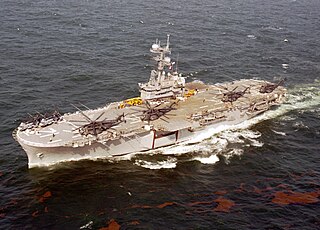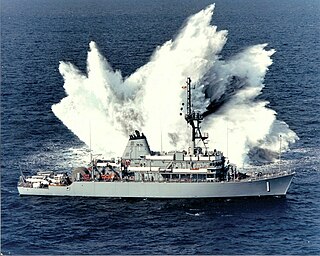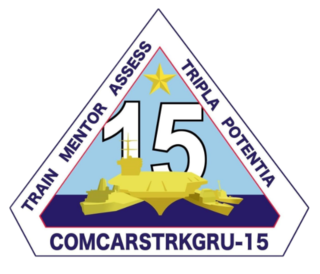Related Research Articles

USS Ronald Reagan (CVN-76) is a Nimitz-class, nuclear-powered supercarrier in the service of the United States Navy. The ninth ship of her class, she is named in honor of Ronald W. Reagan, President of the United States from 1981 to 1989. She was built at Newport News Shipbuilding in Newport News, Virginia, and was commissioned on 12 July 2003.

USS Nimitz (CVN-68) is an aircraft carrier of the United States Navy, and the lead ship of her class. One of the largest warships in the world, she was laid down, launched, and commissioned as CVAN-68, "aircraft carrier, attack, nuclear powered", but she was later redesignated as CVN-68, "aircraft carrier, multi-mission, nuclear-powered", on June 30, 1975, as part of a fleet-wide realignment that year.

USS Abraham Lincoln (CVN-72) is the fifth Nimitz-class aircraft carrier in the United States Navy. She is the third Navy ship to have been named after the former President Abraham Lincoln. Her home port is NAS North Island, San Diego, California; she is a member of the United States Pacific Fleet. She is administratively responsible to Commander, Naval Air Forces Pacific, and operationally serves as the flagship of Carrier Strike Group 3 and host to Carrier Air Wing Nine. She was returned to the fleet on 12 May 2017, marking the successful completion of her Refueling and complex overhaul (RCOH) carried out at Newport News Shipyard. On 1 April 2019, USS Abraham Lincoln was deployed to the Middle East as the flagship for Carrier Strike Group 12 and Carrier Air Wing Seven assigned to her.
USS Ticonderoga (DDG/CG-47), nicknamed "Tico", was a guided-missile cruiser built for the United States Navy. She was the lead ship of the Ticonderoga class and the first U.S. Navy combatant to incorporate the Aegis combat system. Originally ordered as a guided-missile destroyer, she was redesignated as a cruiser after capabilities from the cancelled Strike cruiser program were implemented into the ship's design. The new AEGIS system allowed Ticonderoga to track and engage many aerial targets more effectively than any previous U.S. Navy warship.

The fourth USS Gridley (DDG-101) is the 51st Arleigh Burke-class destroyer in the United States Navy. Gridley is named after Captain Charles Gridley, Commander of Admiral George Dewey's flagship USS Olympia, and recipient of Admiral Dewey's famous command, "You may fire when you are ready, Gridley" in the Battle of Manila Bay during the Spanish–American War.

The 600-ship Navy was a strategic plan of the United States Navy during the 1980s to rebuild its fleet after cutbacks that followed the end of the Vietnam War. The plan, which originated with Republican leaders, was an important campaign plank of Ronald Reagan in the 1980 presidential election, who advocated a larger military and strategic confrontation with the Soviet Union.
Base Realignment and Closure (BRAC) was a process by a United States federal government commission to increase the efficiency of the United States Department of Defense by coordinating the realignment and closure of military installations following the end of the Cold War. Over 350 installations have been closed in five BRAC rounds: 1988, 1991, 1993, 1995, and 2005. These five BRAC rounds constitute a combined savings of $12 billion annually.
Texas A&M University at Galveston (TAMUG) is an ocean-oriented branch campus of Texas A&M University offering both undergraduate and graduate degrees. Students enrolled at Texas A&M University at Galveston, known affectionately as 'Sea Aggies', share the benefits of students attending Texas A&M University (TAMU) campus in College Station. TAMUG is located on Pelican Island, offering benefits for its maritime focused majors.

Naval Station Everett is a military installation located in the city of Everett, Washington, 25 miles (40 km) north of Seattle. The naval station, located on the city's waterfront on the northeastern end of Puget Sound, was designed as a homeport for a US Navy carrier strike group and opened in 1994. A separate Navy Support Complex is located in Smokey Point, 11 miles (18 km) north of Everett near Marysville, and houses a commissary, Navy Exchange, a college and other services.

USS Inchon (LPH/MCS-12) was an Iwo Jima-class amphibious assault ship of the United States Navy in service from 1970 to 2002. Following a major fire, she was laid up and sunk as a target in 2004.

Naval Station Pascagoula was a base of the United States Navy, in Pascagoula, Mississippi. The base officially closed 15 November 2006. The base's property, on Singing River Island in the Mississippi Sound at the mouth of the Pascagoula River, was formally transferred to the Mississippi Secretary of State's office 9 July 2007.

Naval Station Ingleside was a United States Navy base in Ingleside, Texas.

USS Avenger (MCM-1) was the lead ship of her class of mine countermeasures ship, and the third U.S. Navy ship of that name.

USS Pioneer (MCM-9), an Avenger-class mine countermeasures ship of the United States Navy, and is the ninth ship of the class, and the second Navy ship of that name.

Corpus Christi Bay is a scenic semi-tropical bay on the Texas coast found in San Patricio and Nueces counties, next to the major city of Corpus Christi. It is separated from the Gulf of Mexico by Mustang Island, and is fed by the Nueces River and Oso Creek from its western and southern extensions, Nueces Bay and Oso Bay. The bay is located approximately 136 miles (219 km) south of San Antonio, and 179 miles (288 km) southwest of Houston.

The Battle of Galveston Harbor was fought at Galveston, Texas on October 4, 1862, during the American Civil War. After attempts to blockade the Texas coastline were unsuccessful, the Union Navy decided to attempt to capture the port of Galveston. While Galveston was defended by Confederate forces, most of the cannons in the city's defenses were removed, as Galveston was thought to be indefensible. On October 4, five Union naval vessels commanded by Commander William B. Renshaw approached Galveston, and a single ship, USRC Harriet Lane was sent into Galveston Bay under a flag of truce.

Carrier Strike Group 15, is a training formation of the United States Navy. It trains and certifies Pacific Fleet Carrier Strike Groups, Amphibious Ready Groups, and independently deploying surface ships. It replaced Commander, Strike Force Training Pacific in a title change. Carrier Strike Group Four is the equivalent command for US Fleet Forces ships.

Naval Station New York was a United States Navy Naval Station on Staten Island in New York City, closed in 1994.
Naval Station Lake Galveston, is a former United States Navy Naval Station. It was planned for operation in the 1980s during the creation of the Strategic Homeport program under the administration of President Ronald Reagan. It was recommended for closure under the 1988 Base Realignment and Closure Commission, as it was deemed unnecessary with recent cutbacks in the United States Navy.
Naval Station Mobile is a former station of the United States Navy. It opened in 1985 during the creation of the Strategic Homeport program under the administration of President Ronald Reagan. In 1991, the homeport was closed, as part of declining funding under the Base Realignment and Closure Commission (1989).
References
- ↑ "Ports and Harbors". GlobalSecurity.org. 2010. Retrieved 10 May 2010.